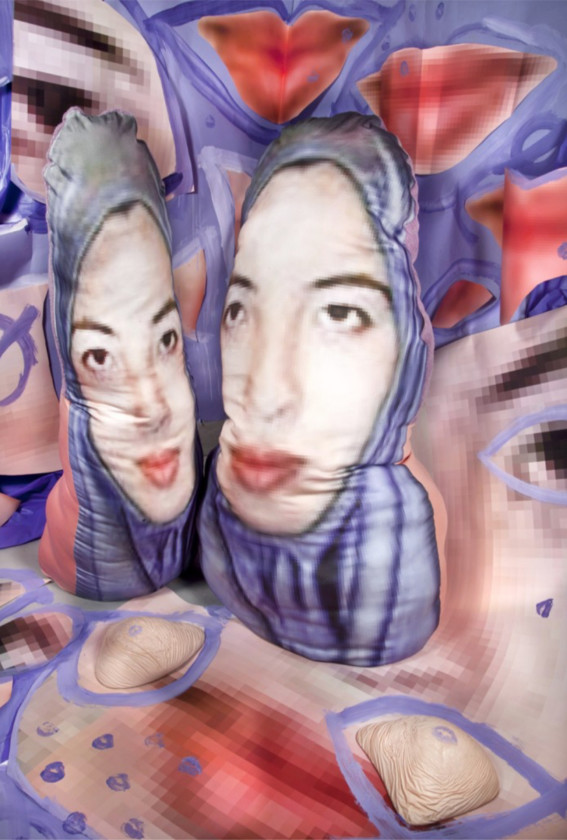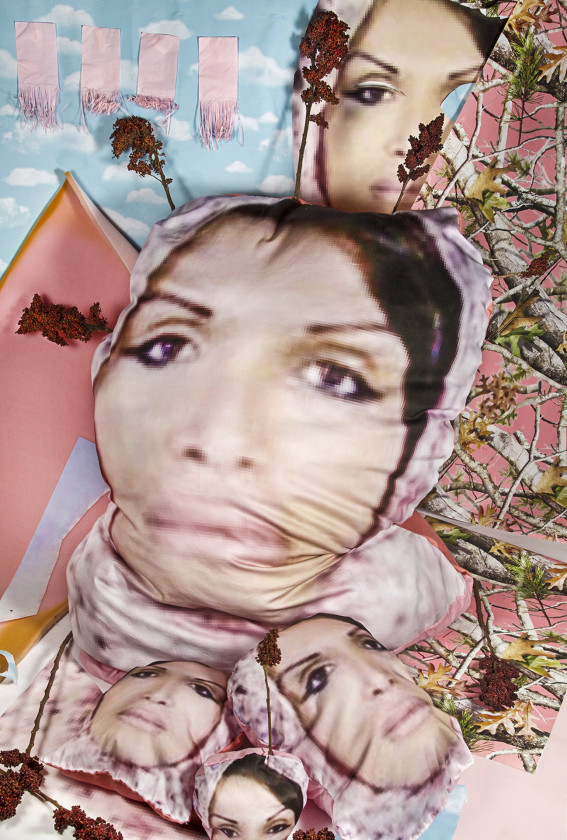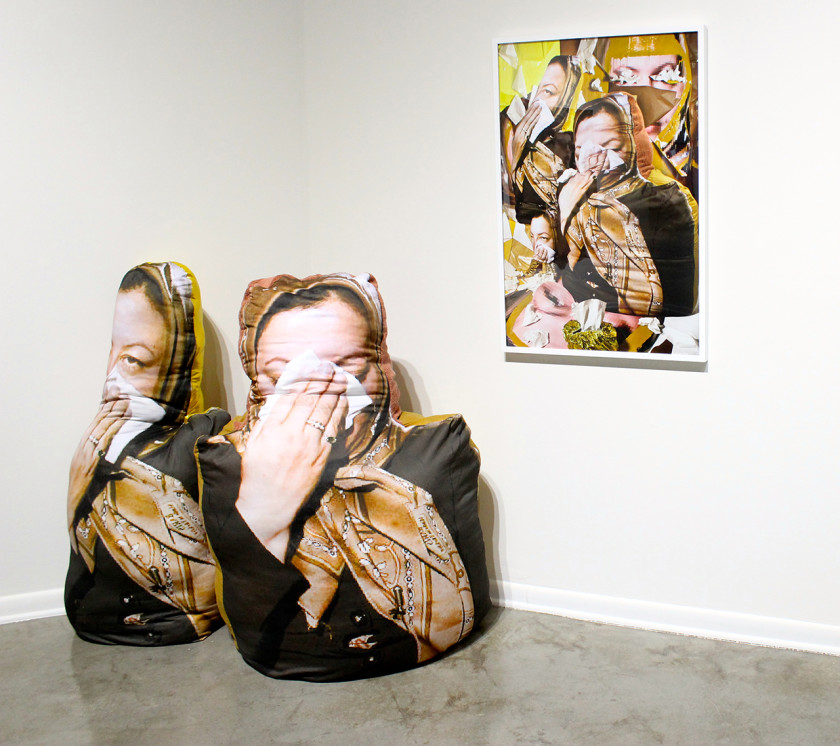Invisible Women: In Conversation with Sheida Soleimani
by Sarah Sharp
Orchestrated by guest curator Samantha ‘Banks’ Schefman of Playground Detroit, Doubly So at Center Galleries on the College for Creative Studies campus is a four-person show of new work. Featuring four artists—Amalia Soto (aka “Molly Soda”), Sheida Soleimani, Sofia Szamosi, Dessislava Terzieva—the work on view in the exhibition shares the common trait of young female artists deeply engaged with technology and social media as a platform for their work. In a show that collectively examines dual identity and contemporary experience via multiple media, Soleimani’s work stands out as the most overtly political and navigates the duality of her Iranian-American heritage via the subject of the execution of female prisoners. We sat down for a brief interview following the show’s opening weekend, to discuss the inspiration and methodology behind her provocative and eye-catching soft-sculpture installations and photographs.

SARAH SHARP: Can you give some background on the work that is on view in Doubly So, specifically?
SHEIDA SOLEIMANI: My parents are both political refugees from Iran and were persecuted during the revolution. My dad was an activist in hiding for three years; he had escaped over the border. My mom was not politically active at all, but she was imprisoned and tortured during their search for my dad.
I was exposed to these issues at a pretty young age, my mom would talk to me about the inequality between men and women in Iran and her personal experience in jail—what her cell looked like, being tortured, how the men treated her, and how it was different for male prisoners. A lot of male prisoners are also tortured and executed, but the discrimination between men and women is unreal.
In a previous series of work called National Anthem, I was looking at a lot of political prisoners tortured by the Iranian government and, oftentimes, executed. All of my work focuses on the Iranian government because of my background growing up with these pretty horrifying stories as a child. Before I made this work, I thought, okay, what’s really important to me? And thought, I need to focus more on the women, because this is what I am really close to and what I hear about a lot. This work, in particular, is about the women that are executed in Iran every year—over 500—many of which go without even being reported by the government. A lot of their families know that they have been imprisoned but they don’t know if they’ve been executed—and then there’s a number of executions that are public, as well, as a way to instill fear in the citizens.
SHARP: And what are they being executed for?
SOLEIMANI: Mostly drug-related charges, drug trafficking, but it is not even confirmed that [the women] have been trafficking drugs. I would say 70-75% are drug-related. Others are just speaking out against the government and religion, and there are women who have been executed for attacking their rapists; freedom of speech is also a big thing, as is sexuality—it is mostly drug-related, though. There are also a number of adultery and murder accusations even though the murder charges are never confirmed.
SHARP: You are saying it is not really well-known how many and who are being executed, so how did you come by this specific information?
SOLEIMANI: I have been in touch with my family in Iran, and they will say, “There’s so much you guys don’t know about, and don’t hear through the U.S. media.” I started digging and found a few Embassy International reports on women that we know, in the West, that have been executed in Iran—one of which was Reyhaneh Jabbari, who attacked her rapist. That became pretty big in Western news.
I started getting in touch with a lot of the lawyers at Iran Human Rights Watch who maintain a PDF of statistics based on who is executed, their names, if they can find them, and what crime they were charged with, etc. That is where I source most of my base information, and then I try to search for the images of the women. Most of the images are Google images—a lot of them are posted by family members that are like, “Have you seen my daughter?” or “Have you seen our mother, this is what she looks like. We think that she was taken in at this time, and can you confirm if she has been executed or not?”
SHARP: What is the story connected with each of the three pieces that are in the show?

SOLEIMANI: Two of the pieces are actually the same woman: Delara Darabi. She was in prison for over ten years, charged with a murder that she was tortured into confessing. She was a very young woman and they kept her in prison for long time, denying her of any rights. She started writing poetry while in prison, talking about her experience, and then randomly one day, without notifying her family, they executed her. It is all based on Sharia law — the judiciary system is literally “an eye for an eye.”
SHARP: And what about the third image?
SOLEIMANI: Sakineh Mohammadi Ashtiani—she was also convicted for murder. So the three in the show were all murder charges that were falsely accused, with no proof, no trial, and were then tortured into confession—they did not get to be heard.
SHARP: Did you make those choices for this particular set of works because it was information you had access to, or the stories spoke to you in a particular way?
SOLEIMANI: I am trying to cover almost every single one of the women that I can find, so it is going to be an ongoing project. These are just the first—they are some of the more easily found images of women that have been executed in Iran, so they are the first two pieces that I made in the series. Now I’m up to ten images, and I’ve been collecting, collecting, collecting.
The only place you can find a trace of their identity is online, at 72 dpi, sized for web—which is crazy, that a trace of a dead woman is 72 dpi, and that is it. So I thought, what would happen if I upsize these images? So I upsize them, I print them on the fabric, and then I fabricate the soft sculptures.
SHARP: So it seems like there is a desire on your part to pull these women back into physical reality in some way.
SOLEIMANI: Absolutely, absolutely. I think to give them some type of form again, and give then some type of shape, instead of just being flat and online, is really important to me. You know, I am not going to bring them back to life or reanimate them in any way, but I am trying to give them some importance, some presence, yeah.
A lot of people react, “Oh, these dolls, they need a hug,” which is an interesting thought. They are not exactly dolls—but they do reference Bandura’s “Bobo doll experiment.” Albert Bandura was a psychologist who in 1961 conducted this experiment with two groups of children. The first group included 20 kids between the ages of six and ten, they went in a room with a huge array of toys to play with for 20 minutes while being observed. Before the second group of children went in—have you seen a Bobo doll before? They’re the clown dolls that are weighted at the bottom, you punch them and they come back up and was in the room in both sets of experiments. The second set of children watched a video of a woman punching the doll before they went into the room and every single one of them behaved aggressively towards the doll.
This work is talking about behavioral psychology, what we absorb and what we see around us—and I was thinking a lot about people in Iran, especially children, that witness these public executions, and find it permissible that there is aggression toward women. If they grow up in an environment where this aggression is permissible, then they will also act out aggressively because they think it is okay. So I thought maybe, by using the soft sculpture to create a compositional cue to relate to the Bobo doll, then I could link those two together.

SHARP: Do you have any feelings about the show, Doubly So—how your work maps with the other women that were included in the show?
SOLEIMANI: I think the title is what pulls all the women together. I think my practice is a little different—Molly Soda is talking about having an internet persona and a real persona, and how those two bridge, and Sofia Szamosi explores what it is to be a woman in image and a woman in real life, through a series of photographs taken over a long period of time. Dessislava Terzieva, with the mediated technology—I could see it having a little bit of a link. But for me, the title Doubly So refers to my work a little more being an Iranian-American woman, and talking about having dual allegiances, and dealing with what is going on in the Middle East through a Western perspective.
Sheida Soleimani currently has a solo show at ROMPONE in Cologne, and another opening at the Biel/Bienne Festival of Photography on April 29. In September (in conjunction with the EXPO Chicago Fair) she will be having a solo exhibition at BOYFRIENDS in Chicago.